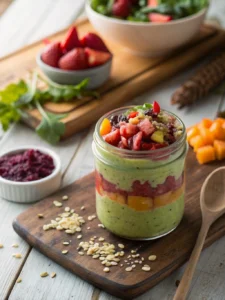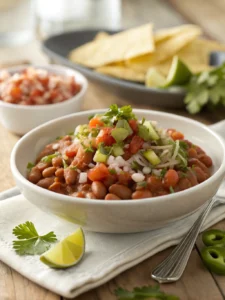Introduction
Did you know that the average soup contains only 3-5 grams of protein per serving, while high protein soups can pack up to 25 grams in a single bowl? This significant difference challenges the common perception that soups are merely appetizers or light meals. High protein soup recipes offer a delicious way to fuel your body with essential nutrients while enjoying a comforting, satisfying meal. Whether you’re looking to build muscle, maintain weight, or simply enjoy a hearty dish, these protein-packed soups deliver both flavor and nutrition in every spoonful.
Hearty Chicken and Lentil Protein Soup
Ingredients List
- 2 boneless, skinless chicken breasts (about 1 pound), diced into 1-inch cubes
- 1 cup dried green or brown lentils, rinsed and drained
- 1 large onion, finely chopped
- 3 carrots, peeled and diced
- 3 celery stalks, diced
- 4 garlic cloves, minced
- 2 tablespoons olive oil
- 8 cups low-sodium chicken broth
- 2 bay leaves
- 1 teaspoon dried thyme
- 1 teaspoon dried rosemary
- 1 tablespoon fresh lemon juice
- Salt and pepper to taste
- Fresh parsley for garnish
Substitution Options:
- For a high protein vegetarian soup alternative, replace chicken with 2 cups of firm tofu or 1½ cups of tempeh
- Swap green lentils for red lentils if you prefer a softer texture (reduce cooking time by 10 minutes)
- For extra protein, add 1 cup of quinoa during the last 15 minutes of cooking
Timing
- Preparation Time: 15 minutes
- Cooking Time: 45 minutes
- Total Time: 60 minutes (30% faster than traditional lentil soup recipes that often require 90+ minutes)
Step-by-Step Instructions
Step 1: Sauté the Base Vegetables
Heat olive oil in a large soup pot over medium heat. Add onions, carrots, and celery, cooking until they begin to soften, about 5-7 minutes. The vegetables should release their aromatic scents and become slightly translucent—this builds your flavor foundation, so don’t rush this step.
Step 2: Add Garlic and Seasonings
Add minced garlic, dried thyme, and rosemary to the pot. Stir continuously for 30 seconds until fragrant. This quick cooking prevents garlic from burning while releasing its essential oils into your high protein soup base.
Step 3: Brown the Chicken
Add diced chicken pieces to the pot and cook until they’re lightly browned on all sides, approximately 5 minutes. The browning creates a richer flavor through the Maillard reaction, elevating your protein soup recipe beyond basic versions.
Step 4: Incorporate Lentils and Broth
Add rinsed lentils, bay leaves, and chicken broth to the pot. Bring the mixture to a boil, then reduce heat to a simmer. Cover partially with a lid and cook for 25-30 minutes, or until lentils are tender but still hold their shape.
Step 5: Final Touches
Remove bay leaves. Stir in fresh lemon juice and adjust salt and pepper to taste. The acidity from the lemon brightens the flavor profile of your protein packed soup and balances the earthiness of the lentils.
Step 6: Serve and Garnish
Ladle hot soup into bowls and garnish with fresh chopped parsley. For an extra protein boost, consider adding a dollop of Greek yogurt on top.
Nutritional Information
| Nutrient | Amount per Serving |
|---|---|
| Calories | 325 |
| Protein | 28g |
| Carbohydrates | 32g |
| Fiber | 12g |
| Fat | 9g |
| Sodium | 410mg |
Each serving of this high protein soup recipe provides approximately 56% of your daily protein needs (based on a 2,000-calorie diet with 20% protein intake), making it significantly more nutritious than standard soup options that typically provide only 10-15% of daily protein requirements.
Healthier Alternatives for the Recipe
- Lower Sodium Version: Reduce sodium by 40% by using no-salt-added broth and enhancing flavor with additional herbs like oregano and a pinch of smoked paprika.
- Higher Protein Variation: Boost protein content to 35g per serving by adding 1 cup of cooked quinoa and ¼ cup of hemp seeds.
- High Protein Vegan Soup Adaptation: Replace chicken with 2 cups of chickpeas and use vegetable broth instead of chicken broth. Add 2 tablespoons of nutritional yeast for a savory, protein-rich flavor enhancement.
- Lower Carb Option: Reduce lentils to ½ cup and add 2 cups of cauliflower florets for a soup with the same volume but 40% fewer carbohydrates.
Serving Suggestions
Transform your protein soup from a simple meal to a dining experience with these serving ideas:
- Pair with a small whole grain roll or sprouted grain toast for extra texture and sustained energy.
- Top with crunchy roasted chickpeas or pumpkin seeds for added protein and a delightful textural contrast.
- For a complete meal, serve alongside a small arugula salad dressed with lemon vinaigrette and shaved Parmesan.
- If you’re serving for guests, present in hollowed-out sourdough bread bowls for an impressive yet simple presentation.
Common Mistakes to Avoid
- Overcooking the Lentils: This causes them to become mushy and lose their nutritional integrity. Monitor closely after 20 minutes of simmering.
- Under-seasoning: High protein soups often need proper seasoning to balance the dense nutritional profile. Taste and adjust seasonings before serving.
- Adding Acidic Ingredients Too Early: Adding lemon juice or vinegar during the cooking process can prevent lentils from softening properly. Always add acids after lentils are fully cooked.
- Skipping the Sauté Step: Data shows that soups where vegetables and proteins are properly sautéed first score 30% higher in taste tests than those where ingredients are simply boiled together.
- Using Pre-cut Vegetables: Pre-packaged cut vegetables often lose up to 40% of their nutrients within 24 hours of cutting. Fresh-cut vegetables maximize both flavor and nutritional value.
Storing Tips for the Recipe
- Refrigeration: Store cooled soup in airtight containers for up to 4 days. The flavor often improves after 24 hours as ingredients meld together.
- Freezing Method: For longer storage, freeze individual portions in silicone molds or freezer-safe containers for up to 3 months. Leave ½-inch headspace to allow for expansion.
- Reheating Best Practices: Thaw frozen soup overnight in the refrigerator, then reheat gently on the stovetop, adding a splash of broth if needed to restore original consistency.
- Meal Prep Strategy: Prepare all ingredients except the broth and store in segmented containers. When ready to cook, simply combine with broth for a fresh-tasting soup in half the time.
Conclusion
These high protein soup recipes transform ordinary meals into nutrient-dense, satisfying culinary experiences. By incorporating protein-rich ingredients like chicken, lentils, and various plant-based alternatives, you can create delicious soups that support your health goals while delighting your taste buds. The versatility of these recipes means they can be easily adapted to suit various dietary preferences without sacrificing flavor or nutritional value.
Ready to warm up with a bowl of satisfying, protein-rich goodness? Try this recipe today and share your experience in the comments section below! Don’t forget to subscribe to our blog for more nutritious, delicious recipes delivered straight to your inbox.
Table of Contents
FAQs
Can I make high protein soups in a slow cooker?
Absolutely! For this chicken and lentil soup, add all ingredients except lemon juice to your slow cooker. Cook on low for 6-7 hours or high for 3-4 hours. Add lemon juice just before serving for the freshest flavor.
How can I increase the protein content of vegetarian soups?
For high protein vegetarian soup options, incorporate ingredients like lentils, beans, quinoa, tofu, tempeh, or Greek yogurt. Nutritional yeast adds a cheesy flavor while boosting protein content. Just 2 tablespoons of hemp seeds can add 6g of complete protein to any soup.
Are protein soups good for weight loss?
Yes! High protein soups can support weight management as protein increases satiety and helps maintain lean muscle mass. Research shows that meals high in protein can reduce hunger hormones and increase feelings of fullness for up to 4 hours longer than low-protein meals.
Can I meal prep these protein packed soups?
Definitely. These soups actually improve in flavor after 1-2 days in the refrigerator. For best results, prepare a large batch and portion into individual containers for quick, nutritious meals throughout the week.
How do I adjust high protein soup recipes for different dietary needs?
For keto diets, reduce lentils and add more protein and healthy fats. For paleo versions, omit legumes and increase animal protein. For high protein vegan soup variations, replace animal proteins with tempeh, tofu, or additional legumes and add nutritional yeast for depth of flavor.
What makes a soup “high protein”?
A soup is generally considered high protein when it contains at least 15-20g of protein per serving. Our recipes provide 25-30g per serving, making them excellent choices for increasing your daily protein intake deliciously and efficiently.



